What's New
Displaying results 1571 - 1580 of 4913
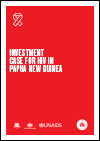
Resource | Publications,
This Investment case for HIV in PNG shows that because of the hard work and considerable investments of the Papua New Guinea (PNG) Government, its international partners, church groups, civil society and people living with HIV, the HIV epidemic has been checked with prevalence at a little under 1 percent of the total population. With estimates in 2000 predicting an HIV epidemic at five times that level, it is clear that investments in HIV work but the job is far from complete. The Investment case for HIV in PNG (“the Investment Case”) also shows that we cannot be complacent: among the general population in the National Capital District, HIV prevalence is 1.6 percent and it is above 1 percent throughout the highlands, where the bulk of the population lives. In some key populations, prevalence is much higher: around 15% of sex workers and 9% of men who have sex with men are living with HIV, and new infections are increasing in both groups. PNG also has the highest STI rates in the region.
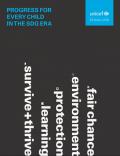
Resource | Publications,
Two years since world leaders committed to achieving the SDGs, are we on track to achieve the goals for children? Do we even have enough information to know? The report “Progress for Every Child in the SDG Era” assesses the world’s performance to date, focusing on 44 indicators that directly concern 2030’s most important constituency: children.
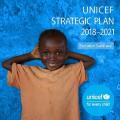
Resource | Publications,
This summary of the UNICEF Strategic Plan, 2018–2021 highlights the organization’s key goals and activities, setting out the concrete results that UNICEF aims to achieve for children with its partners over a four-year period. The summary also outlines the organizational change strategies and enablers envisioned by the Strategic Plan to achieve those results, charting a course towards the attainment of the 2030 Sustainable Development Goals and a better future for every child.
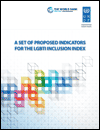
Resource | Publications,
This publication provides a set of 51 indicators in the areas of health, education, civil and political participation, economic empowerment, security and violence. UNDP, in partnership with the World Bank and key civil society partners undertook comprehensive consultations to develop and validate these indicators.
The indicators are in line with the SDG global indicator framework and supported by explanatory notes, as well as references to potential data sources.
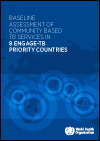
Resource | Publications,
This document contains a series of desk reviews for the eight ENGAGE-TB priority countries supported by the Global Fund (DRC, Kenya, Indonesia, Mozambique, Myanmar, Nigeria, Pakistan and Tanzania). The document provides a situation assessment and gap analysis about the state of community based TB activities in these countries. The focus on these eight countries was justified by the high prevalence of TB and the very high number of missed/unreported cases. To develop the profiles, Global Fund applications, national TB strategic plans and reports, programme review reports, relevant national guidelines and websites of the community stakeholders were examined.
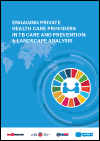
Resource | Publications,
Since 2001, WHO and its partners have offered support on engaging private providers for TB prevention and care, the need for which has been recognized in global TB strategies since 2006. Since 2002, the Public Private Mix Working Group of the Stop TB Partnership (formerly a sub-group of the DOTS Expansion Working Group) has held 13 global meetings on the subject. Several WHO guidance documents have been issued and a number of major reviews of the literature have been published (1–5). While considerable experience has been gained in a wide range of health market contexts, and some countries have made more sustained progress than others, overall engagement of private providers remains weak considering the important role of private providers in many high-burden countries. An essential premise of this document is that global and national goals in TB cannot be achieved unless private providers are engaged on a scale commensurate with their role in health systems.
In this context, the purpose of the landscape analysis is ultimately to facilitate improved engagement of private providers, thereby contributing to universal access to quality and affordable TB care and the end of the TB epidemic. It focuses on the role of private for-profit providers and on specific challenges and experiences in engaging them for TB prevention and care.
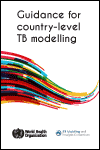
Resource | Publications,
The WHO Global Task Force on TB Impact Measurement provides global oversight to ensure that assessments of progress towards ending TB at global, regional and country levels are as rigorous, robust and consensus based as possible. The Task Force supports countries to improve the analysis and use of TB data for policy, planning and programmatic action, and is committed to the ongoing improvement of model-based policy analysis as a tool for strategic planning and budgeting.
This document aims to provide concrete, pragmatic guidance for how TB modelling and related technical assistance is undertaken to support country decision-making. The target audience for this document are the participants and stakeholders in country-level TB modelling efforts, including the individuals who build and apply models; policy-makers, technical experts and other members of the TB community; international funding and technical partners; and individuals and organizations engaged in supporting TB policy-making.

Resource | Publications,
In 2017, 3.6 million of the estimated 10 million people with TB worldwide were “missed” by national TB programmes (NTPs). Two thirds of them are thought to access TB treatment of questionable quality from public and private providers who are not engaged by the NTP. The quality of care provided in these settings is often not known or substandard. Closing these gaps and ensuring patient-centred care imply that quality-assured and affordable TB services must be made available wherever people choose to seek care.

Resource | Reviews and Snapshots,
This 2018 snapshot is the third annual edition of this publication, showing the prevalence and trends of violence against women in the Asia-Pacific region.
The data in the map and table 2 reflect the most recent (national, if available) data collected with either the WHO methodology, the DHS-DV module, or the UNECE VAW module, from publicly available survey reports, updated in August 2018.






